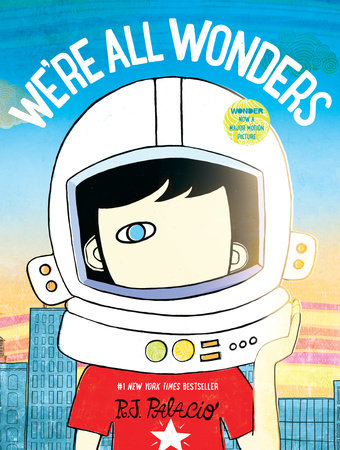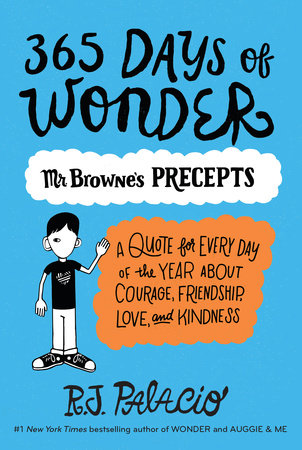Looking with Kindness and Finding Wonder: A Chat with R.J. Palacio
by the Brightly Editors
Five years ago, R.J. Palacio introduced us to Auggie Pullman, the hero of her phenomenal book, Wonder. As a young boy with a severe facial deformity attending school for the first time, Auggie’s story of unwavering compassion and friendship has inspired millions of readers to “choose kind”. Palacio’s powerful message has also inspired a collection of books around Auggie’s story, most recently a picture book for young readers, We’re All Wonders. We were thrilled to chat with R.J. about the idea behind the new picture book, the impact the Choose Kind movement has had on her life, her favorite precept, and the books she loved reading to her children.
Wonder is a Brightly Book Club for Kids pick. Click here to discover Wonder-inspired activities and tips for discussion, and join the reading fun!
Five years later, Auggie is still teaching kids about kindness and will soon be introduced to a whole new group of readers with We’re All Wonders. What does the Choose Kind movement mean to you and how have you tried to incorporate it into your own life?
The thing about choosing kindness on an everyday basis is that it’s not always easy. We all have our good days and our bad days. If someone is unkind to us, or if we hear someone speaking unkindly to other people or about other people, our natural impulse is to strike back, to meet unkindness with unkindness. Maybe not everyone, but most people, I would think, act on the impulse of self-preservation. But if we were to always meet unkindness with unkindness, where would it ultimately get us? Nowhere good. The world would be an awfully hard place to live in. If we want to elevate the level of discourse in society, if we want to raise the bar on how we hope people will treat one another, we have to do better than that. We have to choose kind, as hard as it can be sometimes, so that it becomes the socially accepted norm. It’s worth doing exactly because it is hard, and it’s because it’s hard that we admire it. We admire the people we know who are truly kind. We reap the rewards from people who are kind to us. And we love the way being kind feels when we ourselves are kind. It elevates us as human beings. So, how do I incorporate it into my own life? Look, I’m a born-and-bred New Yorker. Things happen quickly here. Everyone’s always in a rush. Tempers can flare easily. If you keep that refrain, “choose kind,” in your head at all times, though, it has a way of changing your relationship with the world. At the end of the day, all I want — and this is a very selfish wish — is that the world be a kind place for my children. If every mother and father has the same selfish wish for their children, which I think is the case, then, together, we can make it happen for them. I’ve seen how this kindness movement has taken root over the last five years in the generation of kids who will come of age in ten years: we CAN do this for our kids.
Auggie’s teacher Mr. Browne loves to use precepts in his lessons. What is your favorite precept and why?
The first precept I remember collecting — which is to say, I came across a quote that resonated with me and wrote it down — was “Fortune favors the bold” by the ancient Roman poet Virgil. It spoke to me because I’d always felt myself fairly fortunate, but I was also a very hard worker, and I liked the notion that it’s our own efforts and hard work that put us in a position to have good things happen to us. But that was when I was fifteen years old, and my life was in front of me, and being bold suited a vision I had for myself. The precept that resonates the most with me now is Ian Maclaren’s: “Be kind, for everyone you meet is fighting a hard battle.” As you get older, you realize how true this is. If you remember this, which I always try to, you can view everyone with a little with a little extra compassion. It makes you feel a genuine tenderness for other human beings, which helps in choosing kindness.
What do you hope kids take away from reading Wonder? What about parents?
I hope that kids who read Wonder come away with a sense that what they do matters. The choices they make — whom to sit with, what to say, whether to laugh at a joke told at someone else’s expense — might affect other people in ways beyond their comprehension. Would you rather be a Jack or a Julian? Would you rather other people remember you as a nice kid or as a bully? These are their choices to make, and their words and deeds reflect those choices.
As for parents, I hope they’re reminded to keep that bar of expectations raised high for their kids. Don’t buy into that nonsense that “all kids go through a mean phase” in middle school. That’s absurd. We’re so accustomed to a level of meanness passing for normal that we’ve just come to accept it. But it doesn’t have to be that way. Of course, kids that age are finding themselves and testing boundaries, but it doesn’t mean they get to be mean about it. Making new friends doesn’t mean you get to treat your old friends like yesterday’s news. There’s a level of respect and decency that needs to be maintained, and parents need to remind their kids — wherever they happen to fall on the social spectrum of pre-teenness — the golden rule still applies in middle school. Expect them to be kind in all their social dealings. They may fall short from time to time, but that’s part of the learning process in becoming an adult. I’ve met grown-ups who’ve told me they came to kindness later in life, that they weren’t so kind when they were younger — and they regret it. But I’ve never met anyone who said they regret being too kind when they were younger. If you cultivate kindness in a child, they carry it with them forever.
What inspired you to turn Wonder into a picture book? How have you adapted the book’s message for younger audiences in We’re All Wonders?
When I would go into schools to talk about Wonder, I often had teachers state that they would love a picture-book version of Wonder for their younger students. While some people don’t know this about me, my background is in art. I was an illustration major at the Parsons School of Design. I spent most of my adult life as a graphic designer and illustrator. So making a picture book of Wonder seemed like the natural next step for me. I didn’t want to do a straight adaptation of the book, though. How could I possibly distill a 320-page book into 32 pages? So I decided to focus on the idea of being “different” and being “accepted.” I decided, since the book cover was so iconic, to play on that imagery of the face with only one eye — and that’s Auggie’s difference in the picture book. There was no need to go into the level of facial difference he had in the book. It’s enough to know that everyone else has two eyes and two ears and a mouth, but Auggie, in the picture book, doesn’t. I wanted kids to be able to feel Auggie’s isolation and sadness when other kids point and stare at his “differences.” Ultimately, I wanted to focus on the idea that kindness is about how we see the world, not about how we’re seen by it.
What were some of your favorite books as a child?
The Little Prince, D’Aulaires’ Book of Greek Myths, Where the Wild Things Are, Little Women, The Lord of the Rings, Judy Blume…
What are some of the books you’ve loved reading with your children?
I loved reading Horton Hears a Who! and Horton Hatches the Egg to my boys when they were younger. I could read them over and over again every night, and never tire of reading them. I also loved reading Mr. Gumpy’s Outing. One of my favorites. They both had different favorites. My older was really into Eyewitness Books about the ocean, and sharks. I have to admit, it was all I could do to keep awake when I would read these to him. But he loved them, and that’s all that matters. My younger son is more eclectic in his tastes.
-
Books by R.J. Palacio
-
We’re All Wonders
Also available from:Auggie & Me: Three Wonder Stories
Also available from:365 Days of Wonder: Mr. Browne’s Precepts
Also available from:
R. J. Palacio was born and raised in New York City. She attended the High School of Art & Design and got her BFA from the Parsons School of Design, where she majored in illustration. For many years before writing her debut novel Wonder, she worked as a graphic designer and art director. In addition to Wonder, she has written Auggie & Me: Three Wonder Stories and 365 Days of Wonder: Mr. Browne’s Book of Precepts. She lives in Brooklyn, New York, with her husband, their two sons, and their two dogs, Bear and Beau. Learn more about her at rjpalacio.com or on Twitter at @RJPalacio.




